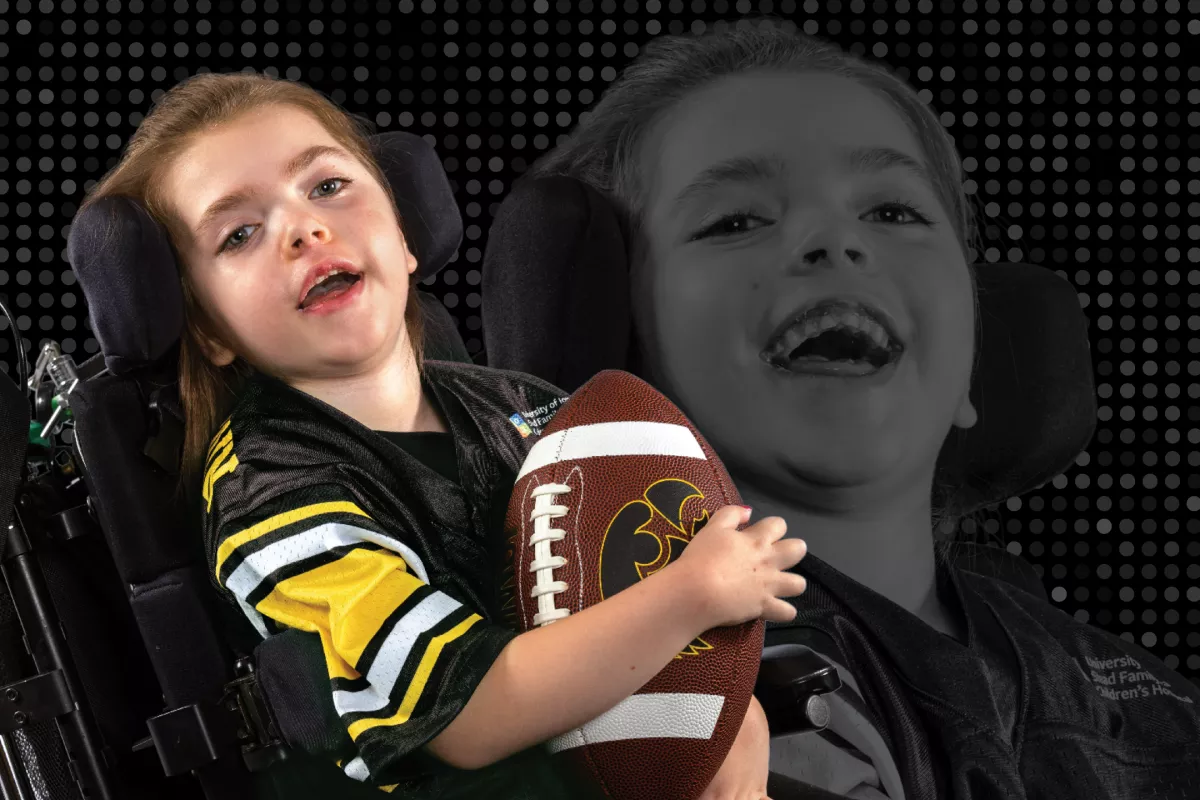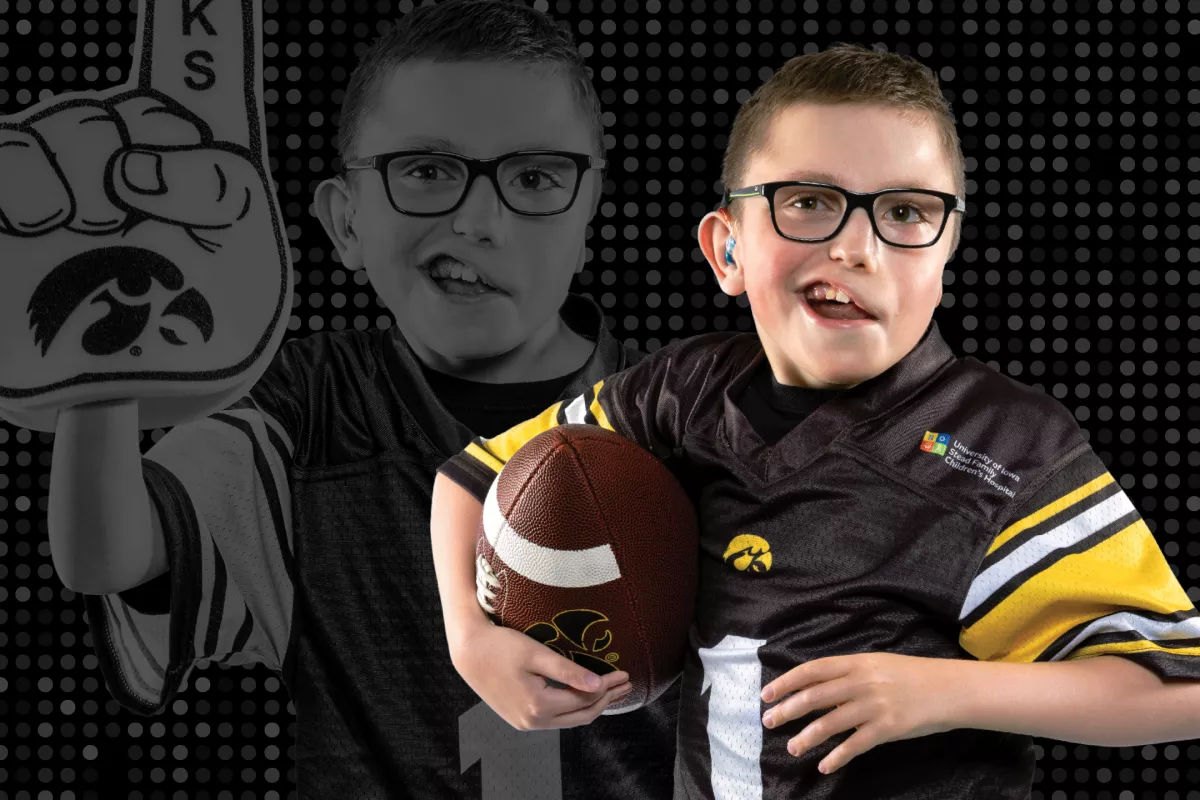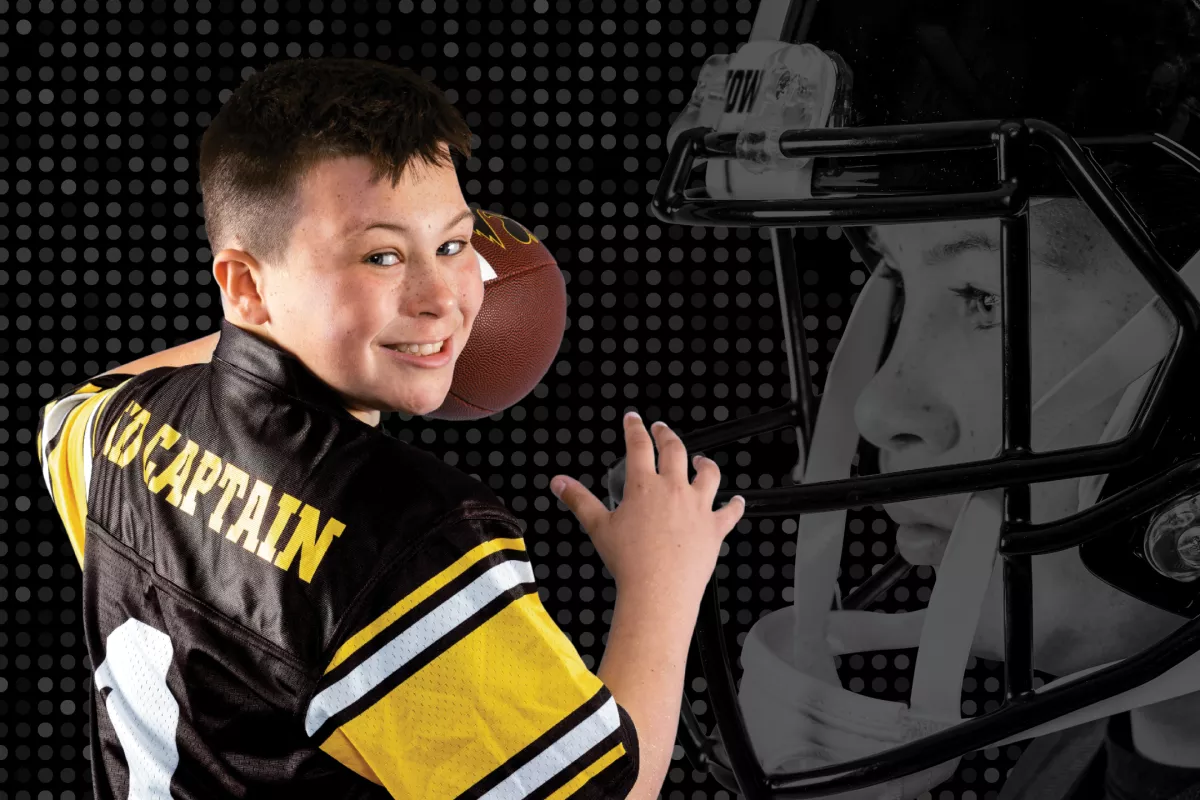Gracelyn Springer, Alburnett, Iowa
Iowa vs. Utah State, Sept. 2
After one month of increasing headaches associated with nausea and vomiting, Gracelyn's left eye started to cross in. She was diagnosed at age 8 with Ewing sarcoma, a cancer that typically occurs in leg bones, or the soft tissue of the chest, abdomen and limbs. But her doctors discovered the tumor in Gracelyn’s head; considered extremely rare. She underwent brain surgery at UI Stead Family Children's Hospital to remove the mass and began chemotherapy. Gracelyn experienced from hearing loss and has been treated for growth hormone deficiency, a condition in which the pituitary gland can’t make enough growth hormone. She also was diagnosed with cardiomyopathy, a disease that makes it harder for the heart to deliver blood to the body. Her cancer is now in remission.

Nile Kron, Iowa City, Iowa

Iowa at Iowa State, Sept. 9
Nile was diagnosed with several health issues after he was born early at 32 weeks at UI Stead Family Children's Hospital. These included a cleft lip and palate, consisting of openings in the upper lip and roof of the mouth. He also had scoliosis—an abnormal curvature of the spine—and a tethered spinal cord, a condition in which the spinal cord abnormally attaches to the spinal canal and vertebrae. His right ear was absent and tissue in his left eyelid was missing, called a coloboma. Doctors performed a series of surgeries, including fixing his cleft lip and palate; separating his spinal cord from his vertebrae; extensive oral surgeries and a hernia removal surgery. He also had two MAGnetic Expansion ControlTM (MAGEC) rods placed in his back to minimize the progression of scoliosis and received cochlear implants to help him hear. Most recently, our surgeons removed five teeth in his nasal airway, related to his cleft lip.
Maggie Larson, Urbandale, Iowa
Iowa vs. Western Michigan, Sept. 16
Maggie’s legs would “crumble” when she tried to walk as a toddler. At 3 years old, she was diagnosed with a rare, terminal disease called metachromatic leukodystrophy. The genetic disorder causes fatty substances to build up in cells, particularly in the brain, spinal cord and peripheral nerves, due to a deficiency of an enzyme that helps break down lipids. Initially told she had a short life expectancy, and nothing could be done, her parents learned about a clinical trial at UI Stead Family Children's Hospital that might slow the progression of the disease. Maggie receives infusions into her spine and has shown improvements in her symptoms and quality of life. She also has received injections to help loosen her muscles to lessen muscle cramping, as well as other care at the hospital.

Gabby Ford, Fairfield, Iowa

Iowa at Penn State, Sept. 23
Gabby was flown to UI Stead Family Children's Hospital after a scan showed she had a buildup of fluid and a mass in the middle of her brain. She was diagnosed with hypothalamic pilocytic astrocytoma, a brain tumor that originates from star-shaped cells called astrocytes. She underwent emergency surgery to relieve pressure in her brain. Doctors later performed a seven-hour debulking surgery, to remove as much of the tumor as possible, and placed a shunt. Gabby underwent chemotherapy, but another scan showed the tumor had increased and the cystic portion was causing hydrocephalus again. She underwent an open craniotomy, and started another chemotherapy protocol, but the tumor growth continued. With the help of our oncology and pharmacy teams, she eventually received a new investigational drug—called DAY101—which has decreased the tumor’s size.
Wyatt Rannals, Cedar Rapids, Iowa
Iowa vs. Michigan State, Sept. 30
Before Wyatt was born, an ultrasound revealed a large cystic hygroma—an abnormal growth along his spine—and he was later diagnosed with hypoplastic left heart syndrome, a rare congenital defect in which the left side of the heart is severely underdeveloped and incapable of supporting systemic circulation. At 5 days old, he underwent pulmonary artery banding surgery at UI Stead Family Children's Hospital to reduce excessive pulmonary blood flow and was listed for a heart transplant. At 2 months old, Wyatt experienced a major stroke. His health deteriorated, but he received a life-saving heart transplant when he was 3 months old. Wyatt has had multiple sets of tubes in his ears, a G-tube, and has had his tonsils removed. He also has had multiple heart catheterization procedures and has been in physical, occupational, and speech therapies.

Max Schlee, Farmersburg, Iowa

Iowa vs. Purdue, Oct. 7
Max and his twin brother appeared to be healthy when they were born, but Iowa’s Newborn Screening program flagged Max for medium-chain acyl-coenzyme A dehydrogenase (MCAD) deficiency, which further tests confirmed. He also was diagnosed with cleft palate, in which the roof of the mouth is split. MCAD, a rare inherited genetic disorder, prevents the breakdown of certain fats needed for energy, leading to dangerously low blood sugar levels. Because of the condition’s rarity, Max was referred to UI Stead Family Children’s Hospital. MCAD has no cure and is managed with a combination of a specialized diet, supplements, and hospitalization. Max has also undergone surgeries and treatment for his cleft palate and severe sleep apnea at UI Stead Family Children’s Hospital, which were managed with IV glucose supplementation and perioperative hospitalization.
Madi Ramirez, LeClaire, Iowa
Iowa at Wisconsin, Oct. 14
When she still wasn’t walking at age 2, Madi was diagnosed with spinal muscular atrophy, a rare inherited disease that causes muscles to increasingly weaken. Her parents were told there was no cure, no treatment, and not much hope. Madi began seeing a nutritionist, orthopedic specialists and, pulmonologists at UI Stead Family Children's Hospital, where she also was diagnosed with autism, attention-deficit/hyperactivity disorder (ADHD), and neurogenic bladder, which causes frequent urination. Around age 11, Madi began having seizures and was diagnosed with 15q duplication, a rare genetic condition. Her doctors worked to find a drug combination that has kept her seizure-free for more than two years, and ensured she had access to new drugs for spinal muscular atrophy that improved her muscle strength. In 2018, Madi underwent spinal surgery for scoliosis and will have surgery in the future to move her jaw forward.

Bentley Erickson, Brainerd, Minnesota

Iowa vs. Minnesota, Oct. 21
Bentley was transferred to UI Stead Family Children's Hospital shortly after he was born at 31 weeks. His left ear was missing, and he was diagnosed with several disorders, including esophageal atresia—a disorder where the upper and lower esophagus do not connect—which prevents food from getting to the stomach, and tracheoesophageal fistula, an abnormal connection between the esophagus and trachea. He also had Goldenhar syndrome, a rare disorder that affects development of the face and skull, and VACTERL association, a group of conditions that affect the vertebrae, anus, cardiac system, trachea, esophagus, renal system (kidneys), and limbs. In addition, Bentley was diagnosed with chronic lung disease and hydrocephalus with a Chiari malformation, in which brain tissue extends into the spinal canal. In his first four years, he underwent 10 surgeries, including life-saving brain and lung operations.
Lincoln Veach, Maquoketa, Iowa
Iowa at Northwestern, Nov. 4
Lincoln had been healthy until around age 4, when he started feeling ill. He was treated for an ear infection but became increasingly tired and his stomach became distended. Tests indicated he had leukemia and Lincoln was referred to UI Stead Family Children's Hospital, where they confirmed his diagnosis of B-cell acute lymphoblastic leukemia, a cancer that affects B lymphocytes, white blood cells that grow in bone marrow. He began chemotherapy, but developed life-threatening necrotizing fasciitis, a sudden bacterial infection that can be fatal. Surgeons removed the infection during a series of operations and Lincoln was given strong antibiotics. Skin from his left leg was used to repair the wound on his right leg. He began physical therapy and resumed chemotherapy and is now able to walk again.

Chloe Dinkla, Winterset, Iowa

Iowa vs. Rutgers, Nov. 11
Chloe’s adoptive family was told she had club foot, but once she arrived from China and was examined at UI Stead Family Children's Hospital, she was diagnosed with additional serious conditions. Chloe had scoliosis, a curvature of the spine; spina bifida, a birth defect in which there is incomplete closing of the spine; tethered spinal cord, when the spinal cord abnormally attaches to the wall of the spinal canal; and a bony mass that split her spinal cord. She had an 11-hour neurosurgical procedure to repair her spinal cord, followed by subsequent operations, including the placement of MAGnetic Expansion Control TM (MAGEC) rods, to minimize the progression of scoliosis. Chloe has also been treated for neurogenic bladder, a cause of bladder control issues; an eye muscle disorder, and Duane syndrome, a congenital eye misalignment that causes difficulties in the eyes moving from side-to-side.
Cooper Estenson, North Liberty, Iowa
Iowa vs. Illinois, Nov. 18
Cooper had been healthy until age 9, when he began having daily headaches and grew increasingly tired, eventually becoming pale, with bruising on his body. He was taken for medical tests and was diagnosed with lymphoblastic T-cell leukemia, a type of blood cancer that begins in the bone marrow and can spread to other organs; considered the most common form of cancer in children. Cooper was hospitalized at UI Stead Family Children’s Hospital and treated with high-dose steroids. He continues on chemotherapy nearly two years later and takes other medications at home. The treatments are expected to continue into next year.

Nathan McDonald, Delta, Iowa

Iowa at Nebraska, Nov. 24
Nathan was transferred to UI Stead Family Children's Hospital shortly after birth when a tumor and spinal deformity in his back were detected. He was diagnosed with infantile myofibromytosis—a rare tumor that grows in the skin, muscles, bones, and sometimes the organs of the chest or abdomen—which can damage nearby organs. He also was diagnosed with kyphosis, an abnormally exaggerated, forward rounding of the upper back which caused an aortic aneurysm, and scoliosis, a sideways curvature of the spine. When he was 5 years old, he began having seizures, which have since been controlled by medication. His tumors have disappeared or grown smaller, and he had extensive orthopedic surgeries to correct his scoliosis and kyphosis. Nathan was the first patient to use a new traction walker in physical therapy to help him regain his balance.
Patient Stories


Related News

